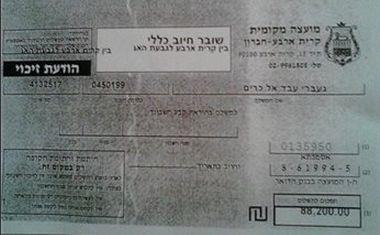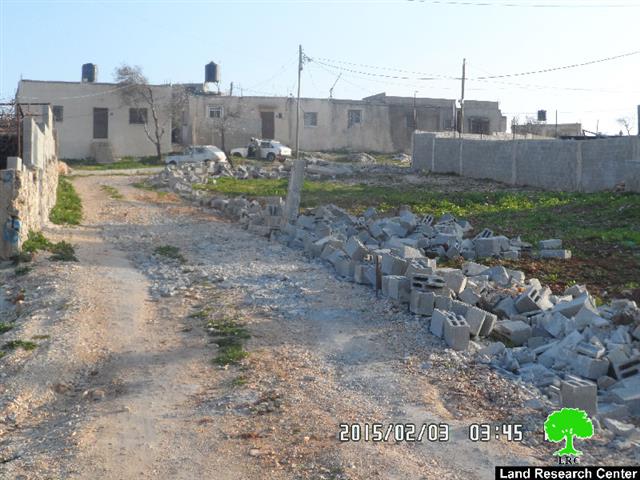On the 21st of January 2015, the Israeli municipal council of Kiryat Arba settlement in heart of Hebron city handed citizen Abdel Karim Al Ja’bari an invoice statement asking him to pay NIS 88,200 (around USD 22,500) as Arnona tax for his land which is located between Kiryat Arba’ settlement and the newly established Giv’at Ha’avot outpost. The statement was handed to citizen Abdul Karim Al Ja’bari under the pretext that his land is located under the jurisdiction of the Kiryat Arba settlement Council;
Additionally, the Kiryat Arba’ settlement council warned Mr. Al Ja’bari that if he doesn’t pay the tax money, the council will impose additional fees on him and eventually confiscate his land, and register it under the existing Tabu rules so that Mr. Al Ja’bari can’t object the seizure of the land in the future. See Map 1
Map 1: the targted land of Al Ja'bari family in the heart of Hebron city
The story of Al Ja’abri family land started back in 2002, when a group of Israeli settlers took over the land of Al Ja’bari family, set up a tent and some caravans and turned the site into a Synagogue. Since that time, settlers escalated their attacks and assaults against Al Ja’bari family members in an attempt to solidify their seizure of the land and hinder Al Ja’bari family from gaining back their property. Al Ja’bari family appealed to the Israeli court regarding the illegal seizure of their land and presented the court with land documents proving their ownership of the property.
To abolish any Palestinian effort to win the case, settlers advocated more settlers from the nearby Israeli settlements and neighborhoods to come and pray in the tent and even live in it. This promoted the Israeli court to issue demolition orders to the tent and the structure on site because the case was still pending at court. This in turn had led to more confrontations between the IOF and settlers who insisted on occupying the site despite court order; and every time the tent was demolished, settlers return on the next morning and build the tent to assure their seizure of the land. It was also reported that settlers attacked family members every time they tried to work in the land, or plant trees and several times family members were prevented from accessing their property.
Recently, a colonial road was also established to link the newly-placed tent and caravans with the main settlement (Kiryat Arba) while electrical poles were constructed to provide the tent and the caravans with electricity.
Three new outposts in the occupied West Bank
On the 4th of July 2014 and following the announcement of kidnapping and killing three Israeli settlers in Hebron Governorate south of the west Bank, Israeli settler groups backed by Israeli settlement councils announced the erection of three new settlement outposts in the occupied West Bank. The land of Al Ja’bari family near Kiryat Arba settlement was among the targeted locations by Israeli settlers, where they erected a tent and other facilities on the land and gave it the name “Talmei Hayem”. See Map 2
Map 2: The location of the three settlement outposts in the occupied West Bank
The “Tabu“ Land Registry Rules
On the 3rd of July 2012, the Israeli daily newspaper published on its website that the State of Israel plans to illegally start compiling land registry files of lands controlled by Israeli settlers in the occupied West Bank throughout the years of occupation; The process is to be implemented by circumventing the regular Tabu land Registry rules so that Palestinians can’t appeal the validity of settlers ownership documents in the future. The initiative was supported by a number of Israeli officials in the Governorate, Mike Blass, Israel’s deputy attorney general; Ahaz Ben-Ari, the legal advisor of the Israeli Ministry of occupation; General Moti Almoz, ex head of the Israeli Civil Administration and the Israeli advisor of the settlement department in the Israeli Ministry of occupation, Eitan Broshi.
This Israeli initiative presents a provoking deterioration in the political situation, because in return for Israel’s withdrawal from all the territories it occupied in 1967 and advancing a way to find an opening for peace with the Palestinians, Israel moves forward with its colonial plans to further consolidate settlers control of Palestinian land by justifying settlers’ lack of formal land ownership documents;
Note that following Israel’s occupation of the Palestinian territory in 1967, the Israeli Civil Administration froze land registration process initiated under Jordanian rule and allocated the majority of lands under "State Land" or “Absentee property” classification. Since that time, Israel began to confiscate Palestinian land under the pretext of "military reasons" and later allowed for the transfer of use of these lands from "military use" to "urban development", which resulted in the establishment of tens of Israeli settlements in the occupied Palestinian territory.
To conclude
Throughout the years of Israeli occupation, Israel encouraged settlers to seize Palestinian land and build settlements whether directly or indirectly; however, the seizure cases were not based on any legal cover by settlers or even by the state of Israel itself (as is the case of previous confiscation cases), which prompted the state of Israel to redress the current situation (random land confiscations carried out by settlers) and work on recognizing settlers’ rights by circumventing the regular land registry rules (the Tabu), to avoid any embarrassments that might result in the future from opening such files at the Israeli courts. For more information, click here: Israel to Activate "Absentee Property Law" to Steal Palestinian Lands in Occupied East Jerusalem
Prepared by:
The Applied Research Institute – Jerusalem
















